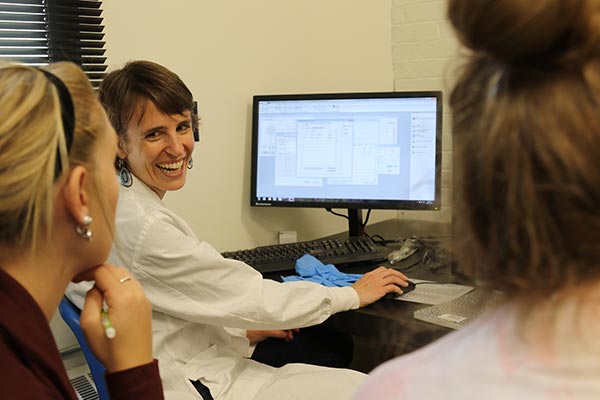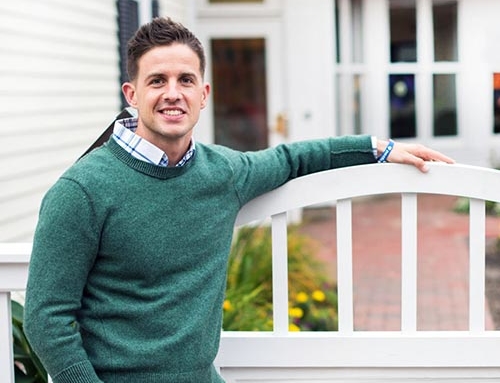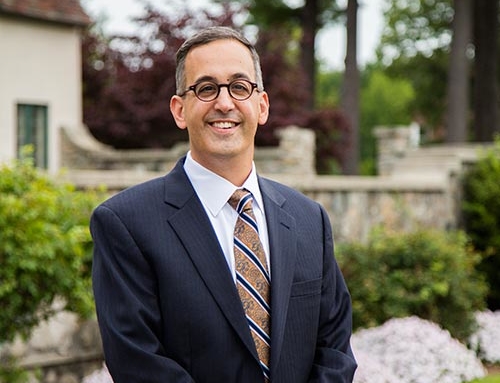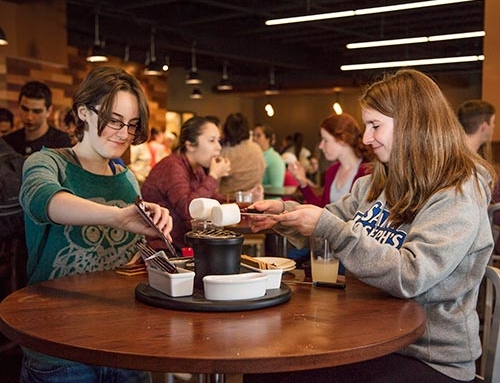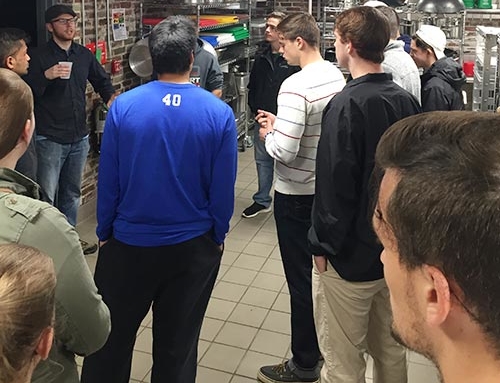Dr. Emily Lesher gathers water samples to analyze for lead content.
By Patricia Erikson
Photo caption: Micaela Mitchell ’17 of Bowdoinham and Michelle Rocker ’17 of Hampden learn from Dr. Lesher. Both of them plan to operate the ICP machine as part of their senior project.
It’s not even 6 a.m. yet and darkness still grips the fall morning. Dr. Lesher pulls her rattling, plastic-wheeled cooler from her car toward Allen Ouellette, faculty and transportation director for the Lisbon School Department. He waits for her, spotlit by an exterior light. After welcoming us warmly, he guides Dr. Lesher down the silent hallway to the locations where she will take samples: the life skills room, the hallway water cooler, and the central kitchen. The two of them dodge orange and black balloons that hang down from the ceiling, remnants of a fall party for the kids.
This summer, a Portland Press Herald article reported that the students and staff of Yarmouth Elementary School would need to drink bottled water because of elevated lead levels in water from the school drinking fountains. Behind this news report, Dr. Emily Lesher of Saint Joseph’s Trace Element Lab in the Sciences Department was using her analytical skills and laboratory equipment to help ensure these school children remain safe.
The Lisbon School Department also invited Dr. Lesher to test water in their public schools this past summer, and again, she found some instances of high lead content. These discoveries—in towns such as Yarmouth, Lisbon, and Benton—have awakened public awareness to the policy gap in protecting children from toxic lead levels in the drinking water. “There is a gap in the state law. Towns don’t have to test water in the schools if it’s public water, but the problem is, even if the municipal water is good, lead often comes from the pipes. Not until 2014 did the laws completely phase out lead in plumbing components, fixtures, and solder. While the greatest childhood lead exposures typically come from paint and dust in older homes, drinking water accounts for about 20% of lead exposure on average, and it is the low-hanging fruit. Removing the source is usually as easy as switching out an older faucet for a new lead-free one,” Dr. Lesher explains.
Given the toxicity of lead for children, test results like these have shaken communities around the state and country. With a PhD in Environmental Science and Engineering and a specialization in environmental chemistry and analytical methods, Dr. Lesher is uniquely qualified to research and properly measure metals in water systems.
I shadowed Dr. Lesher on her trip to Lisbon in October to sample water from school sinks and water fountains. This summer, half of the school water sources that she tested measured at unacceptably high levels. Her first analysis showed there to not be a building-wide problem, and she hypothesized that a construction project may have been impacting the samples that ran high. So, a second visit to Lisbon to retest the sites that measured high over the summer was in order.
Dr. Lesher double checks her notes to ensure that she’s retesting from the same faucet. She unscrews the plastic cap from the sample bottle and captures running water with it. “I’m testing for lead and copper. Acceptable levels for copper are much higher than lead because the metal is not as toxic.” She records her sample on data sheets that she and her summer lab assistant Sarah MacLeod ’18 designed, based upon EPA guidelines.
Next, we move to the dungeon-like boiler room. “We sample here because this is where the water enters the building. It was very stagnant water last time I tested it, this summer. The test is not intended for the situation where the water sits for a week. That’s what happened here when I tested this summer. When the results came back high, I thought, ‘we’ll test it again to see if it’s different during the school year.’”
We’re off to the next school. I rush to keep up with her. In just over 50 minutes she has taken 10 samples from three different schools. As we leave the high school, she turns to Ouellette, “I’m going to run the samples this week and I’ll send a letter to the superintendent with results.”
“This will be good,” Ouellette says, “We’re being proactive, not reactive.”
We say goodbye and head for our cars. “What I and a number of others seem to be seeing across the state,” Dr. Lesher says to me, “is that most problems with high lead are coming from the faucets themselves, and the faucets are fairly cheap and easy to replace. Despite there being a number of high readings in Yarmouth, the cost of the repairs that brought the levels down to acceptable levels was low; less than $2,500.”
Dr. Lesher is also talking with Lewiston; the City passed an ordinance and they want to test the schools. “They have at least five elementary schools there. I can’t do it all by myself. The chemicals and consumables used are expensive. But I have written a grant proposal for Lewiston to help cover the costs of testing water.”
A few days later, I follow Dr. Lesher to her Trace Element Lab in Mercy Hall. Dressed in a white lab coat, she is explaining to students how sample analysis involves a multi-step process. Unexpectedly, the first step is adding acid to “digest” the samples overnight. Dr. Lesher translates that “digest” is a chemist’s way of saying “break down.”
The day before, she had poured 50 milliliters from each sample into plastic tubes and acidified them. Overnight, the samples were heated and concentrated down to 25 ml. She wags the glass vial in front of me, “This concentrates the lead or copper by a factor of two and makes it easier to measure their presence. The digested sample is compared with calibrated standards so that we can control the precision of measurement.”
She shows two students—Micaela Mitchell ’17 and Michelle Rocker ’17—how to place the sample into the ICP machine. Looking through a view window, we watch the machine subject the sample to a 6,000-degree flame (technically called an “argon plasma” that’s as hot as the surface of the sun). The machine measures the spectrum of light given off and can identify the metals present.
Micaela explains, “I’m studying how metals affect freshwater fish. I will be setting up experiments with fish in tanks with different metal exposures, and then measuring metals in their tissue, like in their gills and internal organs.” Michelle explains, “I’m working in the up-and-coming field of phytoremediation. This is where you try and use plants to take up metals, like zinc, from the soil. I will be sampling soil and plant materials and then measure metal content.” These senior students are the next generation of chemists who will help tackle our nation’s challenges.
In addition to her teaching, Dr. Lesher’s research and advocacy are having an effect. She has been meeting with officials from the Maine departments of Environmental Protection and of Education, representatives from water utilities and public school representatives to continue working on this problem. The group is hoping to have a program in place soon that funds school districts to have their water tested with help from the water districts. Lesher hopes to expand her work to include more outreach, perhaps to science classrooms in the schools she works with. “I think there’s a natural venue for working together—everyone’s interested in what’s in their water. It would be so great for a few SJC students to come with me to visit a science classroom, talk about water chemistry and analysis, and maybe even turn on a younger student’s interest in pursuing a science major and career.” Maybe even at Saint Joseph’s.
